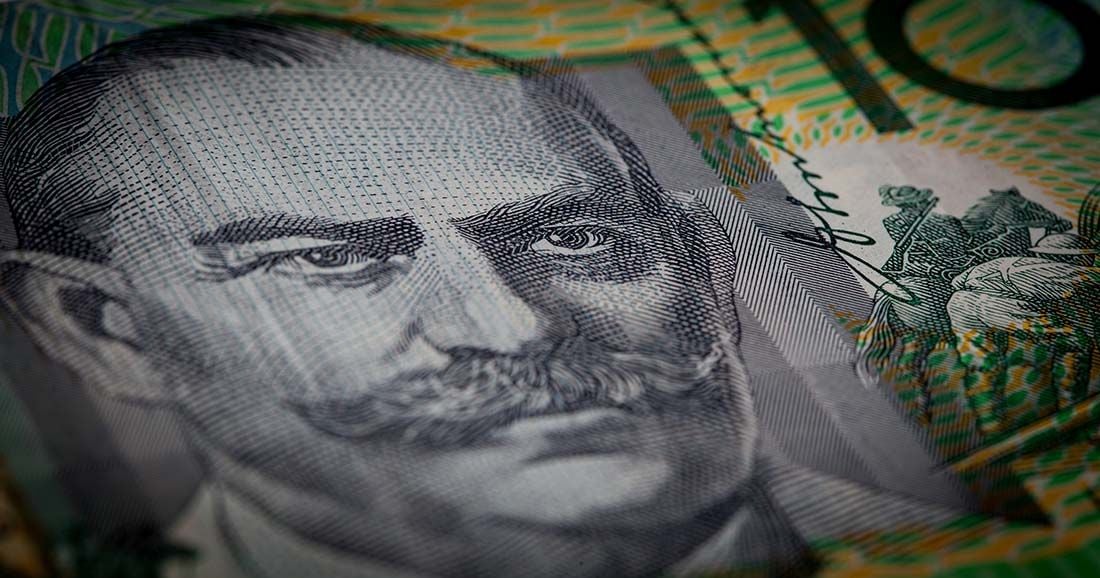The Australian Dollar Hits Bottom of the Barrel as Wage and Inflation Pressures Remain Elusive
- Written by: James Skinner
-AUD falls after Q2 wage price index underwhelms the market.
-Confirms inflation pressures missing in action, cements RBA on hold.
-Data comes as traders shun AUD amid global market tensions.

© Greg Brave, Adobe Stock
The Australian Dollar fell Wednesday after official data confirmed that wage and inflation pressures are still missing in action down under, while traders continue to shun the Antipodean currency amid a testing geopolitical and global economic environment.
Australian pay packets rose by 0.6% during the second-quarter, up from 0.5% at the start of the year and in line with market expectations, although this still left the annualised pace of wage growth sitting at 2.1%. And much of the lift in quarterly wage pressures owes itself to increases in public sector pay, not organic growth in the private sector.
"Wage growth remains weak and remarkably so across industries, sectors and states. At a national level, the only real sign of any lift in wages was in the public sector, particularly in Victoria, with a focus mostly in health services. But even here the heat appears to be limited and the pace of growth has peaked," says Justin Smirk, an economist at Australia's second largest lender by market capitalisation, Westpac.
Wage growth is a hot-button issue for the Australian Dollar because rising or falling household incomes have significant influence over demand growth within an economy and therefore, over inflation too.
Just like with wages, Aussie inflation has been too low for too long, remaining beneath the lower band of its 2% to 3% target for much of the last six years.
"The 10yr average for private sector wage inflation is 3.0%yr. Wage growth in the private sector hit a peak of 4.4%yr in mid-2008," Smirk writes, in a breifing for clients Wednesday. "Our momentum measure of wage pressure reported as the number of sectors that have wage inflation greater than 2.5%yr as just 2, a small rise from 1 in Q1 but well off the recent peak of 8 in 2015 Q2."
Changing levels of unemployment can also have a significant impact on wage growth, and thereby inflation, so Thursday morning's labour market statistics for July will also draw the market's attention.
Consensus if for the Aussie economy to have created 15,000 new jobs during July, down from 59,900 in June, and for the unemployment rate to have held steady at 5.4%.
"After a soft patch in early 2018, some firmer employment prints recently, have lifted the underlying trend, which is now more in line with the stronger leading indicators and business surveys," says Adam Cole, chief currency strategist at RBC Capital Markets. "The firmer pace of overall activity, despite softness in housing, should also see solid employment outcomes continue."
It is inflation that central banks are attempting to manipulate when they tinker with interest rates, which are of course the raison d'être for most moves in currency exchange rates. Changes in interest rates impact currencies significantly because of the push and pull influence they have over international capital flows and their allure for short-term speculators.
An absence of sufficient wage and inflation pressures has seen the Reserve Bank of Australia hold its interest rate at a record low of 1.5% for two years now, and markets are pessimistic about the prospect of a change coming any time soon.
"The AUD weakened after the on-market wage print but softer consumer confidence, but is holding above US$0.72 for now. Should risk-off persist, the next target opens 0.7150 supports followed by cycle lows near 68c," says Mazen Issa, an FX strategist at TD Securities.
The RBA's interest rate stance has seen the Australian Dollar given a drubbing on currency markets this year, particularly as central banks elsewhere in the world are now raising their own rates, which is closing the gap between interest rates offered to investors down under and those available elsewhere.
The Aussie has long enjoyed support from interest rates that were higher than those elsewhere in the world. But the RBA's 1.5% cash rate is now lower than the 1.75% rate of the Federal Reserve in the US, which has put the AUD/USD rate under notable pressure.
Other exchange rates may soon follow suit if the Bank of Canada, Bank of England and European Central Bank continue to raise their interest rates, or otherwise normalise their monetary policies by withdrawing crisis-era stimulus from their respective economies.
"AUD out of favour across the board, likely on concerns linked with China. AUDCAD slammed to new two-year lows over the last couple of sessions. Tonight’s employment data from Australia are the next event risk," says John Hardy, chief currency strategist at Saxo Bank.
And then there is 2018's increase in uncertainty about the global economic outlook, brought on by President Donald Trump's "trade war" with China, as well as a litany of other geopolitical disputes including the Turkish currency crisis that has roiled financial markets in the last week.
These factors have also put pressure on the Australian Dollar due to its sensitivity to changes commodity prices, the changing fortunes of the Chinese economy and the global market's oscillating tolerance of risk.
"With a nearly flat US yield curve & copper breaking to a new low this week, we’re surprised AUD/$ has not fallen further. Expect a test of 0.7160, 2016 low," says Chris Turner, global head of FX strategy at ING Group.
The AUD/USD rate was quoted 0.21% lower at 0.7220 Wednesday while the Pound-to-Aussie rate was up 0.04% at 1.7581. The Aussie was also quoted lower against most other developed world currencies for the session.
Advertisement
Get up to 5% more foreign exchange by using a specialist provider to get closer to the real market rate and avoid the gaping spreads charged by your bank when providing currency. Learn more here




